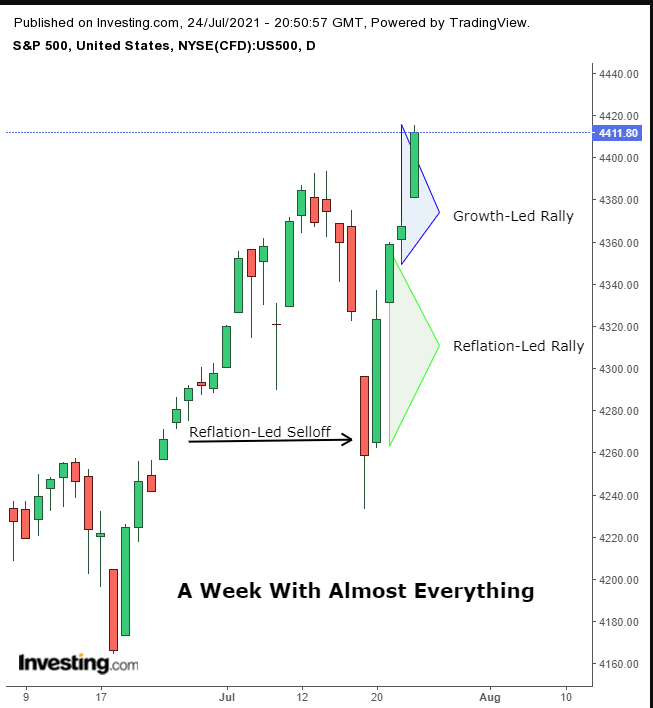- Approximately 165 S&P 500 companies set to release results this coming week
- Stocks rally, but so do Treasuries
Trading last week began with fears that inflation and the still spreading pandemic would deflate the much-anticipated US recovery. Five days later, however, equity markets finished the week with an array of new record highs on Friday, as well as the Dow Jones closing above 35000 for the first time, as investors focused on stellar corporate results as earnings season ramped up.
With marquee technology and industrial names such as Microsoft (NASDAQ:MSFT), Alphabet (NASDAQ:GOOGL), Tesla (NASDAQ:TSLA), Apple (NASDAQ:AAPL), Boeing (NYSE:BA), Amazon (NASDAQ:AMZN) and Caterpillar (NYSE:CAT) set to report earnings in the upcoming week, investors will likely continue focusing on earnings rather than economic or pandemic woes.
However, with another FOMC press conference on tap Wednesday after the Fed's monthly meeting, markets will be carefully paying attention to any nuanced changes or differences in upcoming Fedspeak.
New Highs But Unclear Investor Intentions
All four major US indices—the S&P 500, NASDAQ, Russell 2000 and of course the Dow—finished the week on high notes, with all indices but the Russell seeing a boost of +1% on the week. The Russell 2000 underperformed its peers. The small cap index, whose listed domestic firms are the most representative of value stocks expected to provide the best returns on a restarting economy, finished 6.8% below its Mar. 15 record.
During the course of last week, investor interest flipped from value to growth stocks, though, on Friday, defensive sectors such as Utilities and Healthcare outperformed. Still, tech sector stalwart Communications Services also had a solid finish.
All told, during earnings season thus far, 87% of corporate releases bested estimates—a key catalyst shifting investor attention away from macroeconomic and geopolitical concerns.

Does this all mean the market accepted on faith Fed Chair Jerome Powell's recent, repeated assurances that the current rate of inflation is just transient and therefore doesn't warrant the removal of accommodation? There's no simple answer to that question.
It appears that retail traders are back in force. According to Vanda Research, via Bloomberg, last Monday alone, when stocks were plummeting, retail traders bought a record $2.2 billion worth of equities. That’s the result of fiscal policy that just gives away free money, coupled with monetary policy that disincentives saving because of nonexistent yield.
Could that mean that this kind of dip-buying by retail traders indicates faith in US economic growth? Two components of this market activity make that argument less than convincing. First, dip buying by day-traders reflects nothing about the future since there's no clear indication anything will be held for either the short or long term.
Second, retail traders don’t necessarily pay as much attention to Fedspeak, as do institutional traders. Therefore, the current record rally does not necessarily prove that those retail investors bought equities because they believed the Fed's take that inflation is temporary. Indeed, it's unclear what they believe, if anything.
This dichotomy—of growth sectors boosting markets during economic stagnation (especially when these rallies include defensive stocks) and slumping markets when the narrative continues to chat up a strong recovery—is perhaps best illustrated in the following U.S 10-year Treasury chart.

While stocks have been skyrocketing, Treasury yields are down 26% since mid-March. That means that even as investors are buying the dips, they're hording safe haven Treasuries.
That's not exactly a gesture of faith in the economy. Still, last week’s powerful hammer, with its extremely long, lower shadow, demonstrates that Treasury bears pushed back, which may be a sign the Treasury rally which caused yields to slump is coming to an end. If yields shoot up from here, that will support equities.
We could see the same lack of risk concerns via gold trading.

The yellow metal completed a rising flag, which could signal another leg down.
The Week Ahead
All times listed are EDT
Monday
4:00: Germany – Ifo Business Climate Index: expected to climb to 102.1 from 101.8.
10:00: US – New Home Sales: seen to rise to 800K from 769K.
Tuesday
8:30: US – Core Durable Goods Orders: anticipated to grow to 0.8% from 0.3%.
10:00: US – CB Consumer Confidence: forecast to fall to 124.1 from 127.3.
21:30: Australia – CPI: probably edged up to 0.7% from 0.6% QoQ and jumped to 3.8% from 1.1% YoY.
Wednesday
8:30: Canada – Core CPI: likely to remain flat at 0.4%.
10:30: US – Crude Oil Inventories: previous reading showed a build of 2.108M Bbl.
14:00: US – Fed Interest Rate Decision, FOMC Statement: the central bank is expected to hold rates at 0.25%.
Thursday
3:55: Germany – Unemployment Change: predicted to rise to -25K from -38K.
8:30: US – GDP: forecast to soar to 8.6% from 6.4% QoQ.
8:30: US – Initial Jobless Claims: last week's print disappointed, coming in at 419K.
10:00: US – Pending Home Sales: seen to crash to 0.5% from 8.0%.
Friday
2:00: Germany – GDP: predicted to surge to 2.0% from -1.8%.
5:00: Eurozone – CPI: expected to edge up to 2.0% from 1.9%.
8:30: Canada – GDP: likely to remain flat at -0.3% MoM.
21:00: China – Manufacturing PMI: anticipated to edge lower to 50.8 from 50.9.
